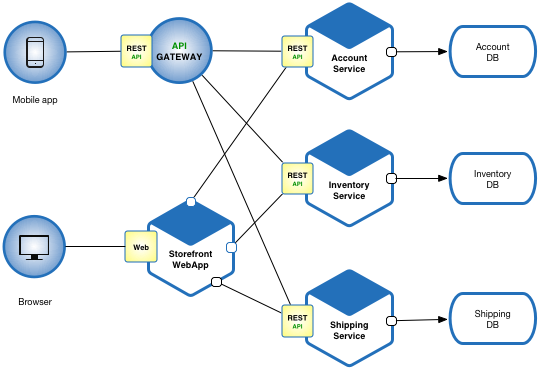Microservices: Revolutionizing Software Architecture
In the ever-evolving world of software development, the need for scalable, maintainable, and flexible systems has led to the rise of microservices architecture. This approach has become a cornerstone of modern application design, enabling organizations to build complex systems that are easier to develop, deploy, and scale. In this article, we’ll explore what microservices are, their benefits, challenges, and best practices for implementing them.
1. What Are Microservices?
Microservices is an architectural style that structures an application as a collection of small, independent, and loosely coupled services. Each service is responsible for a specific business capability and can be developed, deployed, and scaled independently. Unlike monolithic architectures, where all components are tightly integrated into a single codebase, microservices promote modularity and decentralization.
Key Characteristics of Microservices:
- Single Responsibility: Each microservice focuses on a single business function.
- Independence: Services are developed, deployed, and scaled independently.
- Decentralization: Services can use different technologies, databases, and frameworks.
- Communication: Services interact via lightweight protocols like HTTP/REST, gRPC, or messaging queues.
2. Microservices vs Monolithic Architecture
To understand the value of microservices, it’s helpful to compare them with traditional monolithic architectures.
Monolithic Architecture:
- Single Codebase: All components are tightly coupled and deployed as a single unit.
- Scalability: Scaling requires replicating the entire application.
- Development: Changes to one component may require rebuilding and redeploying the entire application.
- Technology Stack: Limited to a single technology stack.
Microservices Architecture:
- Modular: Components are broken into independent services.
- Scalability: Individual services can be scaled independently based on demand.
- Development: Teams can work on different services simultaneously without affecting others.
- Technology Diversity: Each service can use the best technology for its specific needs.
3. Benefits of Microservices
Microservices offer numerous advantages that make them ideal for modern, complex applications:
3.1 Scalability
Microservices allow you to scale only the components that require additional resources. For example, if the payment service of an e-commerce platform experiences high traffic, you can scale just that service without affecting others.
3.2 Flexibility
Teams can choose the best technology stack for each service. For instance, a machine learning service might use Python, while a user authentication service might use Node.js.
3.3 Faster Development
Independent services enable parallel development. Teams can work on different services simultaneously, reducing time-to-market.
3.4 Resilience
Failure in one service does not necessarily bring down the entire system. Properly designed microservices can isolate failures and maintain overall system availability.
3.5 Continuous Deployment
Microservices support continuous integration and deployment (CI/CD), allowing teams to release updates to individual services without disrupting the entire application.
3.6 Improved Maintainability
Smaller, focused codebases are easier to understand, test, and maintain compared to monolithic applications.
4. Challenges of Microservices
While microservices offer significant benefits, they also come with challenges that need to be addressed:
4.1 Complexity
Managing multiple services, their interactions, and deployments can be complex. Tools like Kubernetes and Docker are often used to simplify orchestration and containerization.
4.2 Data Management
Maintaining data consistency across services can be challenging. Techniques like eventual consistency and distributed transactions are often used.
4.3 Network Latency
Inter-service communication over the network introduces latency. Efficient communication protocols and caching mechanisms can mitigate this.
4.4 Monitoring and Debugging
With multiple services, monitoring and debugging become more complex. Centralized logging and monitoring tools like Prometheus, Grafana, and ELK Stack are essential.
4.5 Organizational Change
Adopting microservices often requires a shift in organizational structure, moving from centralized teams to small, cross-functional teams responsible for individual services.
5. Best Practices for Implementing Microservices
To successfully implement microservices, follow these best practices:
5.1 Define Clear Boundaries
Each microservice should have a well-defined responsibility and boundary. Use domain-driven design (DDD) to identify bounded contexts.
5.2 Use API Gateways
An API gateway acts as a single entry point for clients, routing requests to the appropriate services and handling cross-cutting concerns like authentication and rate limiting.
5.3 Implement Service Discovery
Service discovery tools like Consul or Eureka help services locate and communicate with each other dynamically.
5.4 Ensure Fault Tolerance
Use patterns like circuit breakers and retries to handle failures gracefully. Tools like Hystrix can help implement these patterns.
5.5 Adopt CI/CD Pipelines
Automate testing, integration, and deployment to ensure rapid and reliable delivery of services.
5.6 Monitor and Log
Implement centralized logging and monitoring to gain visibility into the system’s health and performance.
5.7 Secure Communication
Use secure communication protocols like HTTPS and implement authentication and authorization mechanisms to protect services.
6. Real-World Examples of Microservices
Many leading companies have adopted microservices to power their applications:
- Netflix: Uses microservices to handle millions of users and deliver personalized content.
- Amazon: Transitioned from a monolithic architecture to microservices to support its vast e-commerce platform.
- Uber: Leverages microservices to manage ride requests, payments, and real-time tracking.
7. When to Use Microservices
Microservices are not a silver bullet. They are best suited for:
- Large, complex applications with multiple teams.
- Systems requiring high scalability and flexibility.
- Organizations with mature DevOps practices.
For smaller applications or startups, a monolithic architecture might be more appropriate due to its simplicity.
8. Conclusion
Microservices have revolutionized the way we design and build software systems. By breaking down applications into smaller, independent services, organizations can achieve greater scalability, flexibility, and resilience. However, adopting microservices requires careful planning, the right tools, and a shift in organizational mindset.
As technology continues to evolve, microservices will remain a key architectural pattern for building modern, cloud-native applications. By understanding their benefits, challenges, and best practices, you can harness the power of microservices to create robust and scalable systems that meet the demands of today’s digital world.

